Cerebral Palsy: Intervention Strategies for Sensory and Motor Issues
VerifiedAdded on 2022/08/18
|15
|3926
|18
Essay
AI Summary
This essay addresses the multifaceted challenges of cerebral palsy (CP), focusing on a 2-year-old child presenting with hypotonic trunk, increased limb tone, and developmental delays. The essay emphasizes the importance of a multidisciplinary approach to manage the condition, including the use of visual and proprioceptive feedback to improve knee joint sensation, active and passive low load stretching to enhance joint mobility and postural control, and ankle-foot orthoses (AFOs) to prevent plantar flexion. The essay discusses the physiological underpinnings of these interventions, potential complications, and their indications, while also considering the child's psychological well-being and developmental stage according to Piaget's theory. It highlights the significance of early intervention strategies in improving outcomes for children with CP, referencing relevant research and clinical practices to support the recommended interventions. The essay also discusses the use of medications to address muscle tightness and spasticity, as well as the importance of considering the child's overall health and family dynamics in the treatment plan.
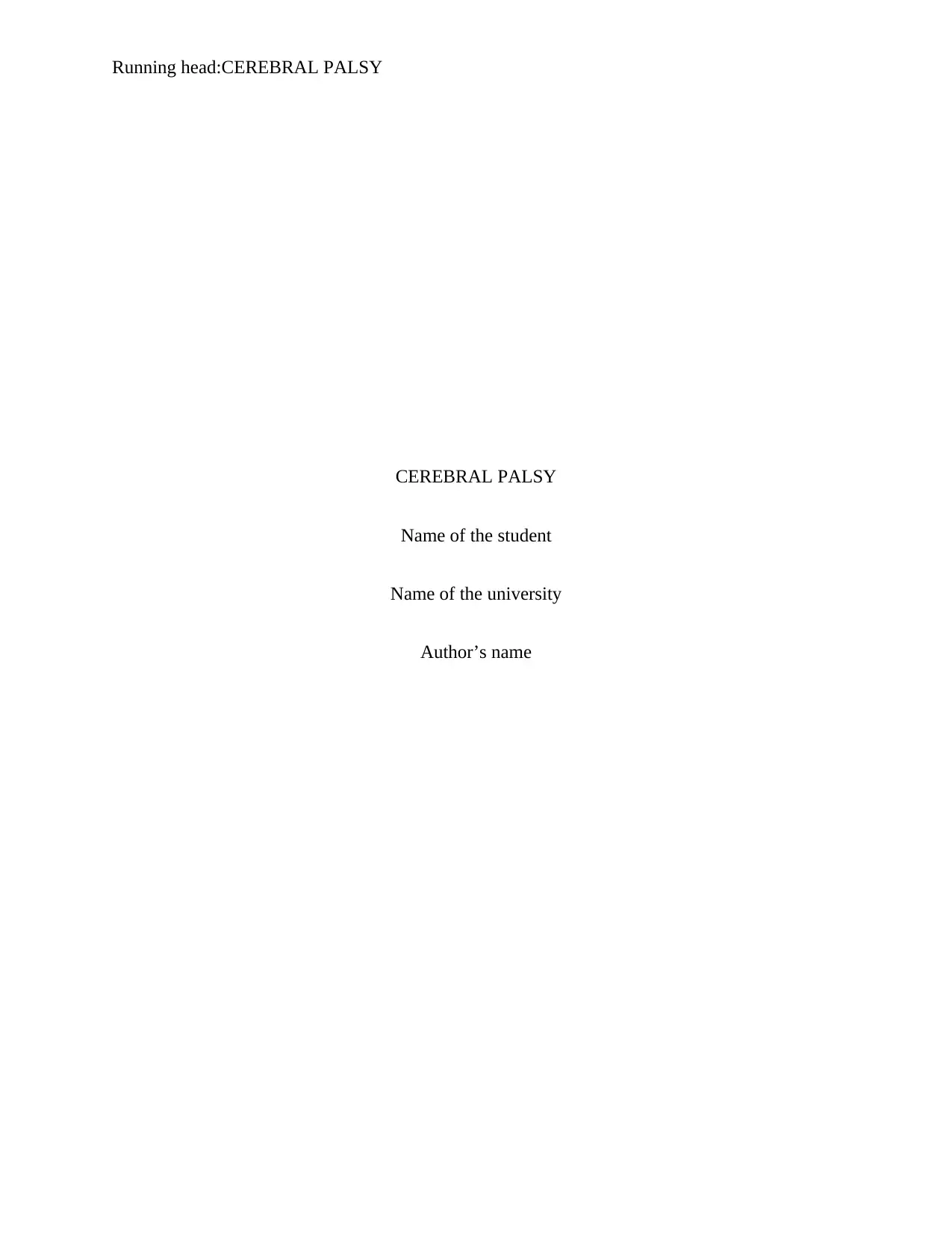
Running head:CEREBRAL PALSY
CEREBRAL PALSY
Name of the student
Name of the university
Author’s name
CEREBRAL PALSY
Name of the student
Name of the university
Author’s name
Paraphrase This Document
Need a fresh take? Get an instant paraphrase of this document with our AI Paraphraser
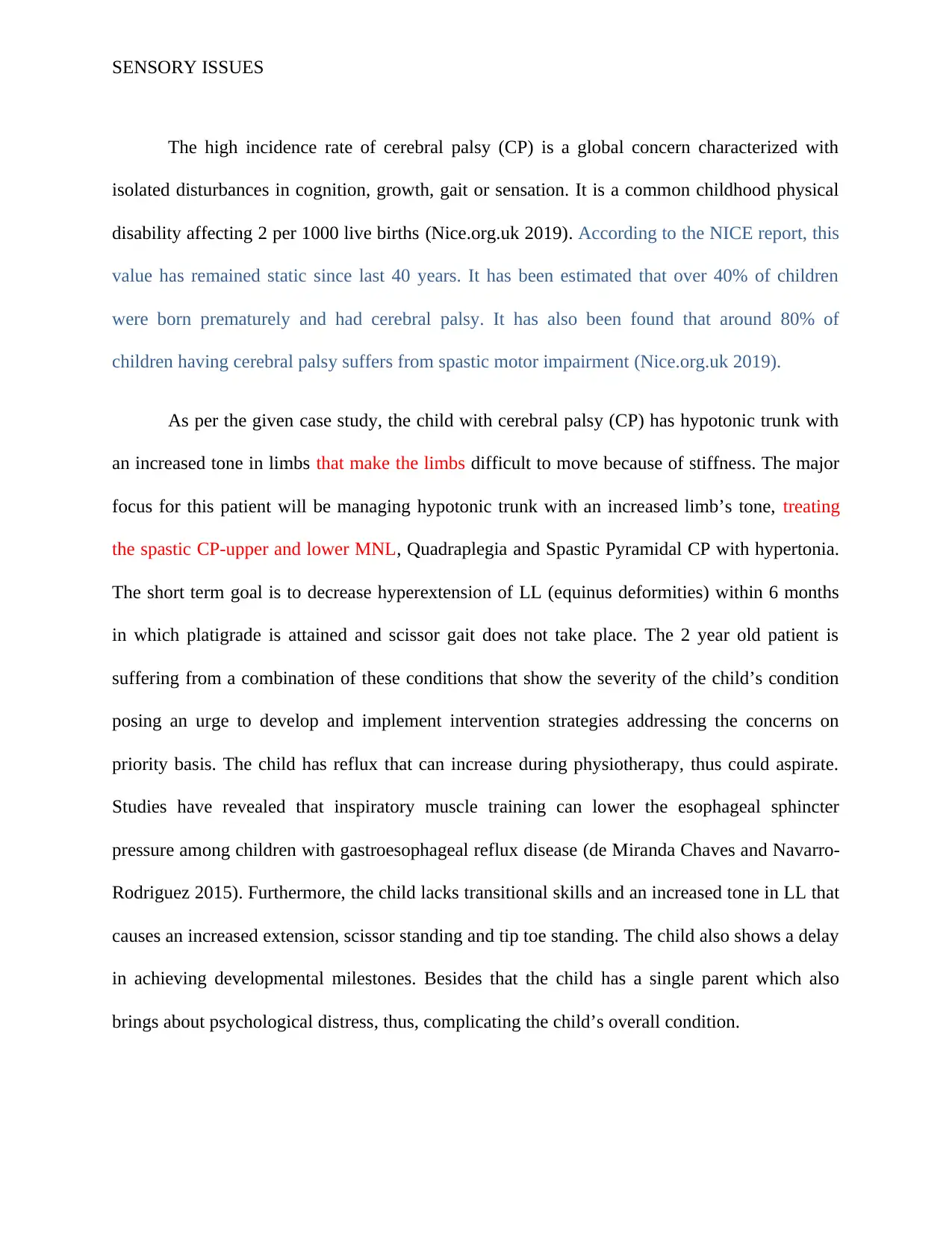
SENSORY ISSUES
The high incidence rate of cerebral palsy (CP) is a global concern characterized with
isolated disturbances in cognition, growth, gait or sensation. It is a common childhood physical
disability affecting 2 per 1000 live births (Nice.org.uk 2019). According to the NICE report, this
value has remained static since last 40 years. It has been estimated that over 40% of children
were born prematurely and had cerebral palsy. It has also been found that around 80% of
children having cerebral palsy suffers from spastic motor impairment (Nice.org.uk 2019).
As per the given case study, the child with cerebral palsy (CP) has hypotonic trunk with
an increased tone in limbs that make the limbs difficult to move because of stiffness. The major
focus for this patient will be managing hypotonic trunk with an increased limb’s tone, treating
the spastic CP-upper and lower MNL, Quadraplegia and Spastic Pyramidal CP with hypertonia.
The short term goal is to decrease hyperextension of LL (equinus deformities) within 6 months
in which platigrade is attained and scissor gait does not take place. The 2 year old patient is
suffering from a combination of these conditions that show the severity of the child’s condition
posing an urge to develop and implement intervention strategies addressing the concerns on
priority basis. The child has reflux that can increase during physiotherapy, thus could aspirate.
Studies have revealed that inspiratory muscle training can lower the esophageal sphincter
pressure among children with gastroesophageal reflux disease (de Miranda Chaves and Navarro-
Rodriguez 2015). Furthermore, the child lacks transitional skills and an increased tone in LL that
causes an increased extension, scissor standing and tip toe standing. The child also shows a delay
in achieving developmental milestones. Besides that the child has a single parent which also
brings about psychological distress, thus, complicating the child’s overall condition.
The high incidence rate of cerebral palsy (CP) is a global concern characterized with
isolated disturbances in cognition, growth, gait or sensation. It is a common childhood physical
disability affecting 2 per 1000 live births (Nice.org.uk 2019). According to the NICE report, this
value has remained static since last 40 years. It has been estimated that over 40% of children
were born prematurely and had cerebral palsy. It has also been found that around 80% of
children having cerebral palsy suffers from spastic motor impairment (Nice.org.uk 2019).
As per the given case study, the child with cerebral palsy (CP) has hypotonic trunk with
an increased tone in limbs that make the limbs difficult to move because of stiffness. The major
focus for this patient will be managing hypotonic trunk with an increased limb’s tone, treating
the spastic CP-upper and lower MNL, Quadraplegia and Spastic Pyramidal CP with hypertonia.
The short term goal is to decrease hyperextension of LL (equinus deformities) within 6 months
in which platigrade is attained and scissor gait does not take place. The 2 year old patient is
suffering from a combination of these conditions that show the severity of the child’s condition
posing an urge to develop and implement intervention strategies addressing the concerns on
priority basis. The child has reflux that can increase during physiotherapy, thus could aspirate.
Studies have revealed that inspiratory muscle training can lower the esophageal sphincter
pressure among children with gastroesophageal reflux disease (de Miranda Chaves and Navarro-
Rodriguez 2015). Furthermore, the child lacks transitional skills and an increased tone in LL that
causes an increased extension, scissor standing and tip toe standing. The child also shows a delay
in achieving developmental milestones. Besides that the child has a single parent which also
brings about psychological distress, thus, complicating the child’s overall condition.
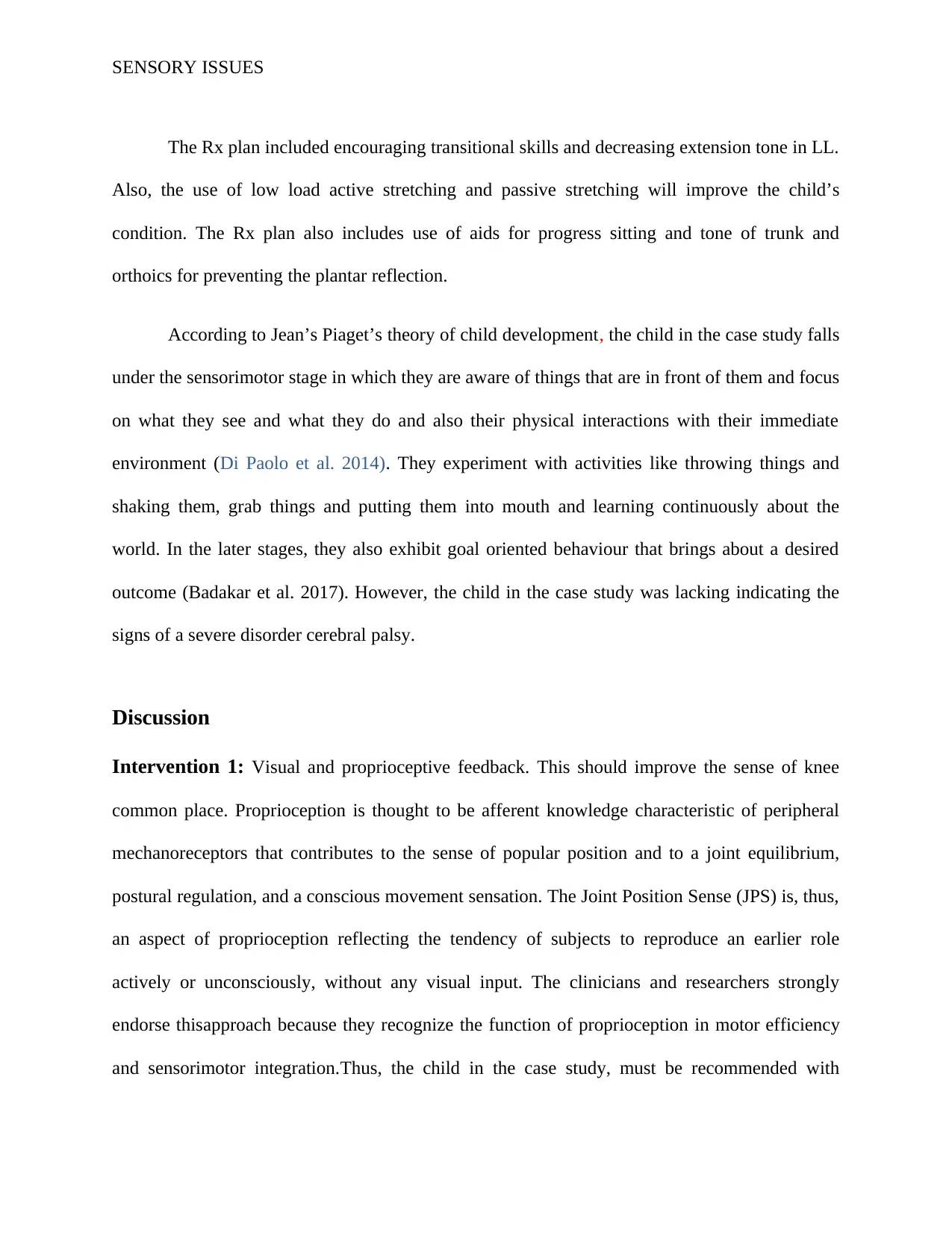
SENSORY ISSUES
The Rx plan included encouraging transitional skills and decreasing extension tone in LL.
Also, the use of low load active stretching and passive stretching will improve the child’s
condition. The Rx plan also includes use of aids for progress sitting and tone of trunk and
orthoics for preventing the plantar reflection.
According to Jean’s Piaget’s theory of child development, the child in the case study falls
under the sensorimotor stage in which they are aware of things that are in front of them and focus
on what they see and what they do and also their physical interactions with their immediate
environment (Di Paolo et al. 2014). They experiment with activities like throwing things and
shaking them, grab things and putting them into mouth and learning continuously about the
world. In the later stages, they also exhibit goal oriented behaviour that brings about a desired
outcome (Badakar et al. 2017). However, the child in the case study was lacking indicating the
signs of a severe disorder cerebral palsy.
Discussion
Intervention 1: Visual and proprioceptive feedback. This should improve the sense of knee
common place. Proprioception is thought to be afferent knowledge characteristic of peripheral
mechanoreceptors that contributes to the sense of popular position and to a joint equilibrium,
postural regulation, and a conscious movement sensation. The Joint Position Sense (JPS) is, thus,
an aspect of proprioception reflecting the tendency of subjects to reproduce an earlier role
actively or unconsciously, without any visual input. The clinicians and researchers strongly
endorse thisapproach because they recognize the function of proprioception in motor efficiency
and sensorimotor integration.Thus, the child in the case study, must be recommended with
The Rx plan included encouraging transitional skills and decreasing extension tone in LL.
Also, the use of low load active stretching and passive stretching will improve the child’s
condition. The Rx plan also includes use of aids for progress sitting and tone of trunk and
orthoics for preventing the plantar reflection.
According to Jean’s Piaget’s theory of child development, the child in the case study falls
under the sensorimotor stage in which they are aware of things that are in front of them and focus
on what they see and what they do and also their physical interactions with their immediate
environment (Di Paolo et al. 2014). They experiment with activities like throwing things and
shaking them, grab things and putting them into mouth and learning continuously about the
world. In the later stages, they also exhibit goal oriented behaviour that brings about a desired
outcome (Badakar et al. 2017). However, the child in the case study was lacking indicating the
signs of a severe disorder cerebral palsy.
Discussion
Intervention 1: Visual and proprioceptive feedback. This should improve the sense of knee
common place. Proprioception is thought to be afferent knowledge characteristic of peripheral
mechanoreceptors that contributes to the sense of popular position and to a joint equilibrium,
postural regulation, and a conscious movement sensation. The Joint Position Sense (JPS) is, thus,
an aspect of proprioception reflecting the tendency of subjects to reproduce an earlier role
actively or unconsciously, without any visual input. The clinicians and researchers strongly
endorse thisapproach because they recognize the function of proprioception in motor efficiency
and sensorimotor integration.Thus, the child in the case study, must be recommended with
⊘ This is a preview!⊘
Do you want full access?
Subscribe today to unlock all pages.

Trusted by 1+ million students worldwide
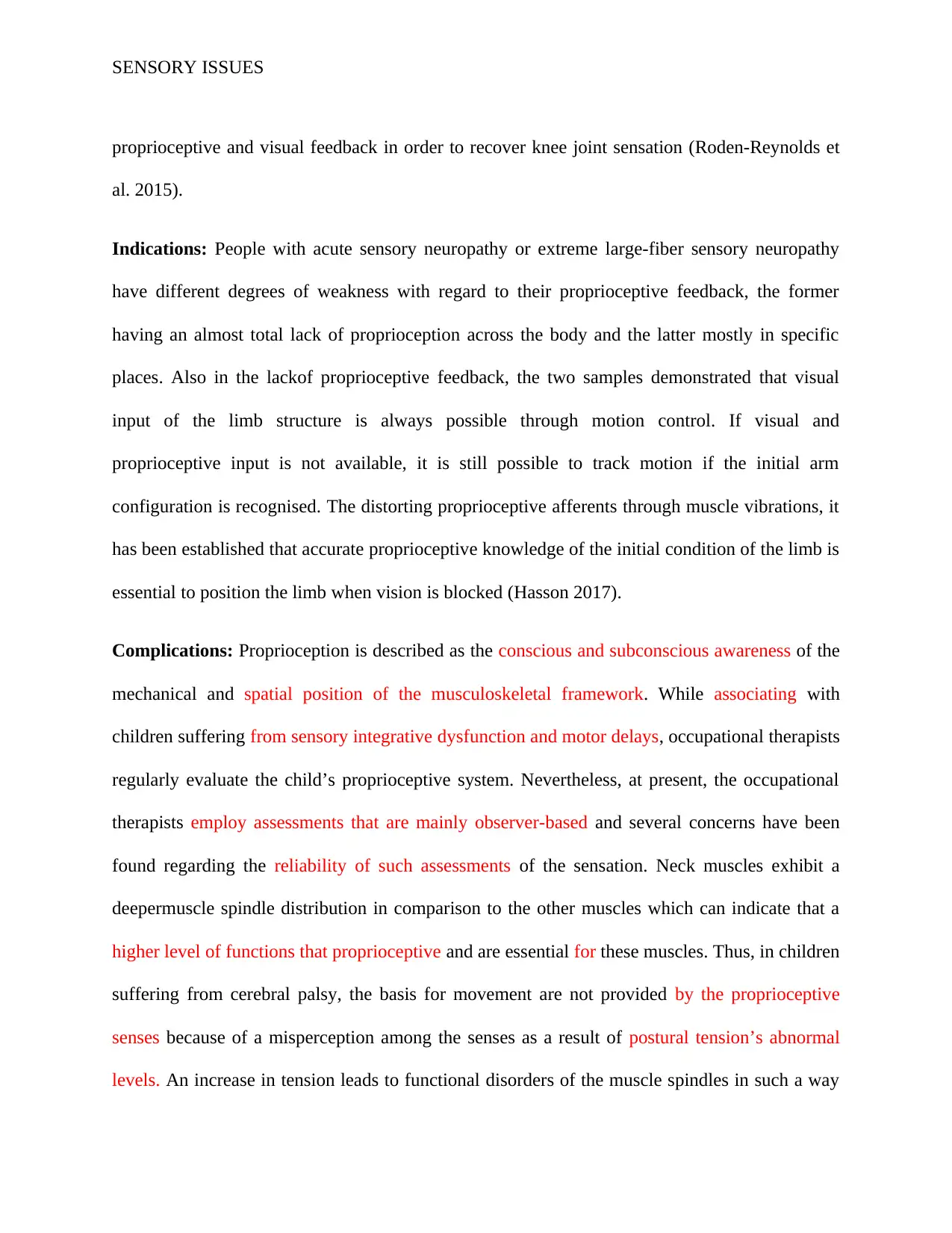
SENSORY ISSUES
proprioceptive and visual feedback in order to recover knee joint sensation (Roden-Reynolds et
al. 2015).
Indications: People with acute sensory neuropathy or extreme large-fiber sensory neuropathy
have different degrees of weakness with regard to their proprioceptive feedback, the former
having an almost total lack of proprioception across the body and the latter mostly in specific
places. Also in the lackof proprioceptive feedback, the two samples demonstrated that visual
input of the limb structure is always possible through motion control. If visual and
proprioceptive input is not available, it is still possible to track motion if the initial arm
configuration is recognised. The distorting proprioceptive afferents through muscle vibrations, it
has been established that accurate proprioceptive knowledge of the initial condition of the limb is
essential to position the limb when vision is blocked (Hasson 2017).
Complications: Proprioception is described as the conscious and subconscious awareness of the
mechanical and spatial position of the musculoskeletal framework. While associating with
children suffering from sensory integrative dysfunction and motor delays, occupational therapists
regularly evaluate the child’s proprioceptive system. Nevertheless, at present, the occupational
therapists employ assessments that are mainly observer-based and several concerns have been
found regarding the reliability of such assessments of the sensation. Neck muscles exhibit a
deepermuscle spindle distribution in comparison to the other muscles which can indicate that a
higher level of functions that proprioceptive and are essential for these muscles. Thus, in children
suffering from cerebral palsy, the basis for movement are not provided by the proprioceptive
senses because of a misperception among the senses as a result of postural tension’s abnormal
levels. An increase in tension leads to functional disorders of the muscle spindles in such a way
proprioceptive and visual feedback in order to recover knee joint sensation (Roden-Reynolds et
al. 2015).
Indications: People with acute sensory neuropathy or extreme large-fiber sensory neuropathy
have different degrees of weakness with regard to their proprioceptive feedback, the former
having an almost total lack of proprioception across the body and the latter mostly in specific
places. Also in the lackof proprioceptive feedback, the two samples demonstrated that visual
input of the limb structure is always possible through motion control. If visual and
proprioceptive input is not available, it is still possible to track motion if the initial arm
configuration is recognised. The distorting proprioceptive afferents through muscle vibrations, it
has been established that accurate proprioceptive knowledge of the initial condition of the limb is
essential to position the limb when vision is blocked (Hasson 2017).
Complications: Proprioception is described as the conscious and subconscious awareness of the
mechanical and spatial position of the musculoskeletal framework. While associating with
children suffering from sensory integrative dysfunction and motor delays, occupational therapists
regularly evaluate the child’s proprioceptive system. Nevertheless, at present, the occupational
therapists employ assessments that are mainly observer-based and several concerns have been
found regarding the reliability of such assessments of the sensation. Neck muscles exhibit a
deepermuscle spindle distribution in comparison to the other muscles which can indicate that a
higher level of functions that proprioceptive and are essential for these muscles. Thus, in children
suffering from cerebral palsy, the basis for movement are not provided by the proprioceptive
senses because of a misperception among the senses as a result of postural tension’s abnormal
levels. An increase in tension leads to functional disorders of the muscle spindles in such a way
Paraphrase This Document
Need a fresh take? Get an instant paraphrase of this document with our AI Paraphraser
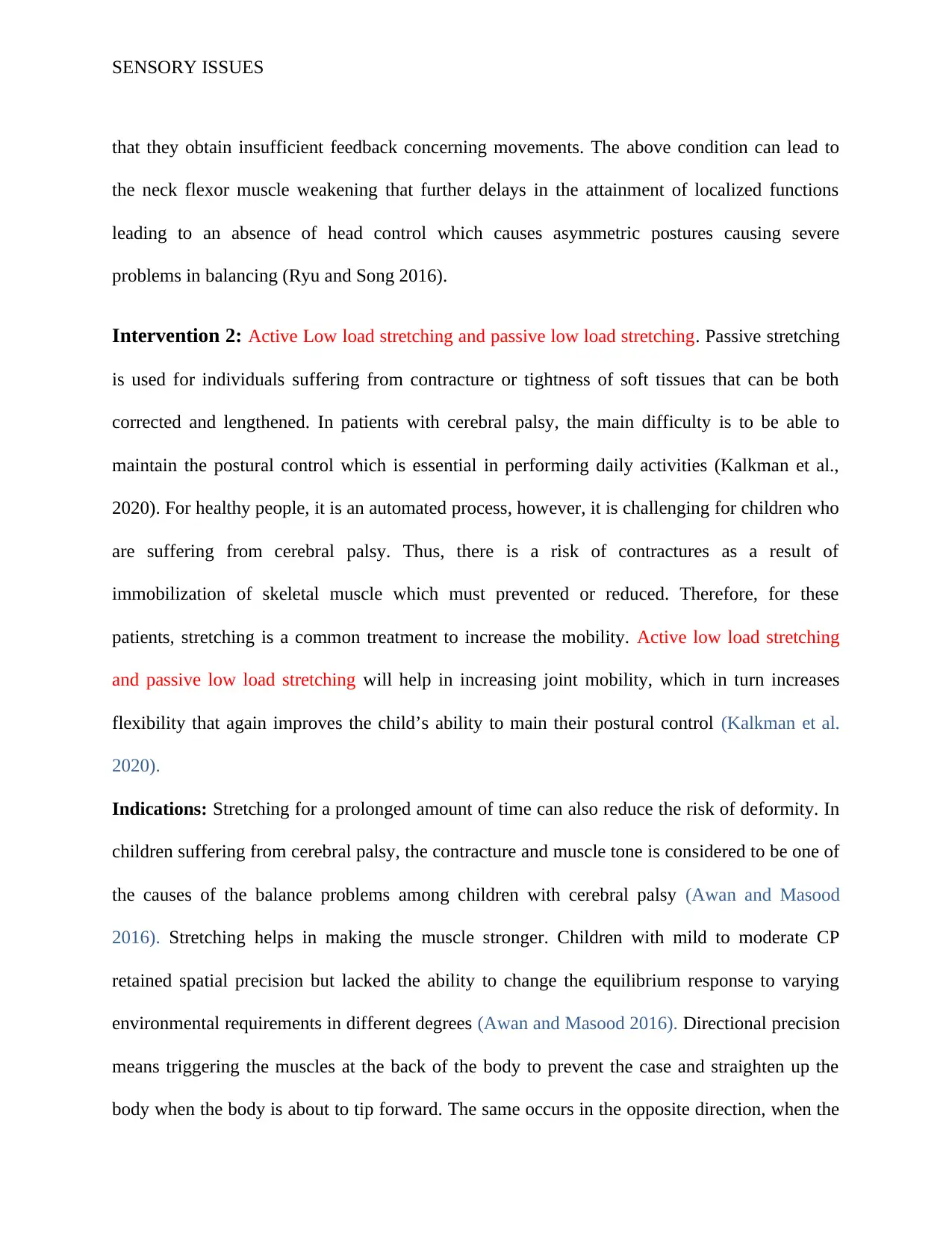
SENSORY ISSUES
that they obtain insufficient feedback concerning movements. The above condition can lead to
the neck flexor muscle weakening that further delays in the attainment of localized functions
leading to an absence of head control which causes asymmetric postures causing severe
problems in balancing (Ryu and Song 2016).
Intervention 2: Active Low load stretching and passive low load stretching. Passive stretching
is used for individuals suffering from contracture or tightness of soft tissues that can be both
corrected and lengthened. In patients with cerebral palsy, the main difficulty is to be able to
maintain the postural control which is essential in performing daily activities (Kalkman et al.,
2020). For healthy people, it is an automated process, however, it is challenging for children who
are suffering from cerebral palsy. Thus, there is a risk of contractures as a result of
immobilization of skeletal muscle which must prevented or reduced. Therefore, for these
patients, stretching is a common treatment to increase the mobility. Active low load stretching
and passive low load stretching will help in increasing joint mobility, which in turn increases
flexibility that again improves the child’s ability to main their postural control (Kalkman et al.
2020).
Indications: Stretching for a prolonged amount of time can also reduce the risk of deformity. In
children suffering from cerebral palsy, the contracture and muscle tone is considered to be one of
the causes of the balance problems among children with cerebral palsy (Awan and Masood
2016). Stretching helps in making the muscle stronger. Children with mild to moderate CP
retained spatial precision but lacked the ability to change the equilibrium response to varying
environmental requirements in different degrees (Awan and Masood 2016). Directional precision
means triggering the muscles at the back of the body to prevent the case and straighten up the
body when the body is about to tip forward. The same occurs in the opposite direction, when the
that they obtain insufficient feedback concerning movements. The above condition can lead to
the neck flexor muscle weakening that further delays in the attainment of localized functions
leading to an absence of head control which causes asymmetric postures causing severe
problems in balancing (Ryu and Song 2016).
Intervention 2: Active Low load stretching and passive low load stretching. Passive stretching
is used for individuals suffering from contracture or tightness of soft tissues that can be both
corrected and lengthened. In patients with cerebral palsy, the main difficulty is to be able to
maintain the postural control which is essential in performing daily activities (Kalkman et al.,
2020). For healthy people, it is an automated process, however, it is challenging for children who
are suffering from cerebral palsy. Thus, there is a risk of contractures as a result of
immobilization of skeletal muscle which must prevented or reduced. Therefore, for these
patients, stretching is a common treatment to increase the mobility. Active low load stretching
and passive low load stretching will help in increasing joint mobility, which in turn increases
flexibility that again improves the child’s ability to main their postural control (Kalkman et al.
2020).
Indications: Stretching for a prolonged amount of time can also reduce the risk of deformity. In
children suffering from cerebral palsy, the contracture and muscle tone is considered to be one of
the causes of the balance problems among children with cerebral palsy (Awan and Masood
2016). Stretching helps in making the muscle stronger. Children with mild to moderate CP
retained spatial precision but lacked the ability to change the equilibrium response to varying
environmental requirements in different degrees (Awan and Masood 2016). Directional precision
means triggering the muscles at the back of the body to prevent the case and straighten up the
body when the body is about to tip forward. The same occurs in the opposite direction, when the
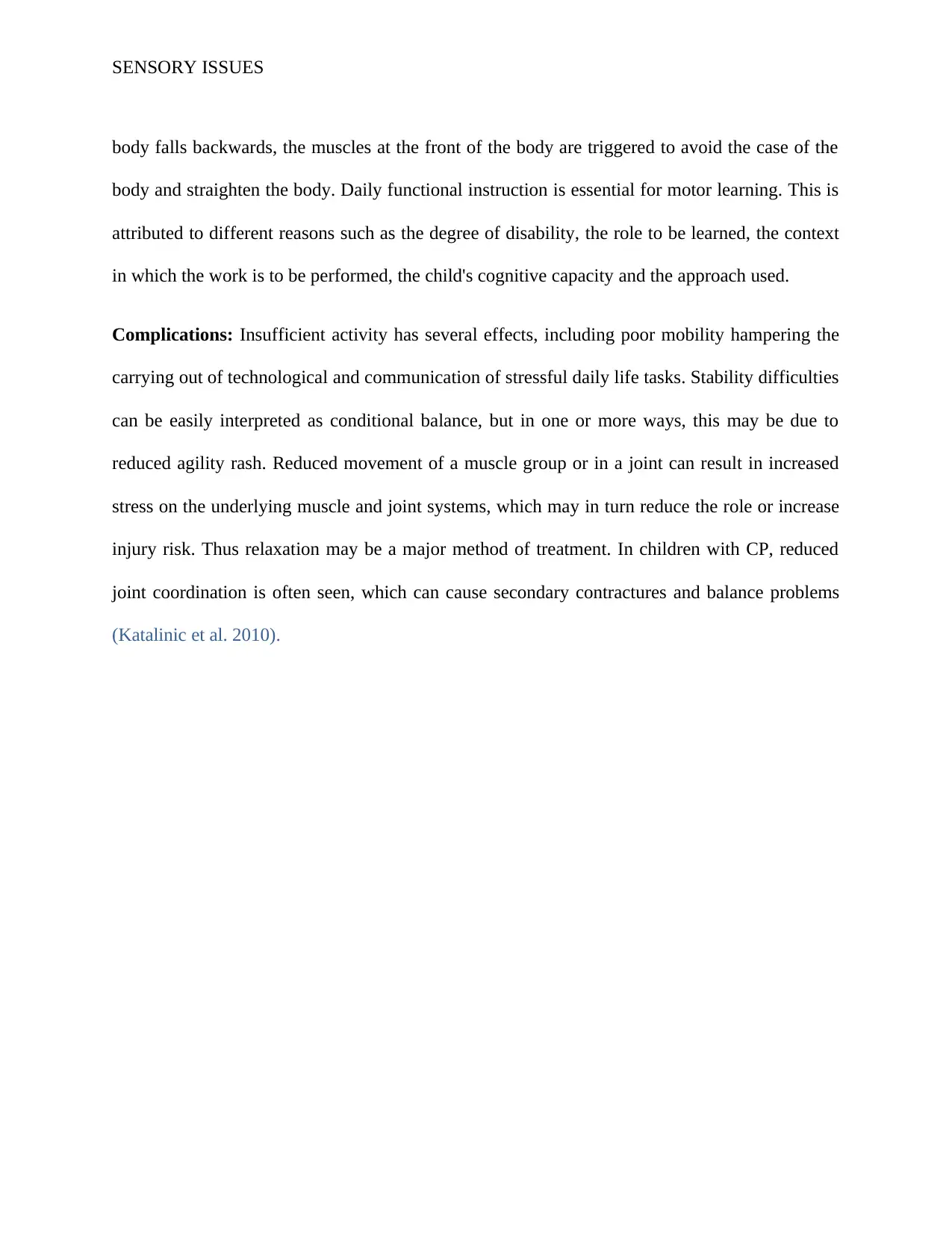
SENSORY ISSUES
body falls backwards, the muscles at the front of the body are triggered to avoid the case of the
body and straighten the body. Daily functional instruction is essential for motor learning. This is
attributed to different reasons such as the degree of disability, the role to be learned, the context
in which the work is to be performed, the child's cognitive capacity and the approach used.
Complications: Insufficient activity has several effects, including poor mobility hampering the
carrying out of technological and communication of stressful daily life tasks. Stability difficulties
can be easily interpreted as conditional balance, but in one or more ways, this may be due to
reduced agility rash. Reduced movement of a muscle group or in a joint can result in increased
stress on the underlying muscle and joint systems, which may in turn reduce the role or increase
injury risk. Thus relaxation may be a major method of treatment. In children with CP, reduced
joint coordination is often seen, which can cause secondary contractures and balance problems
(Katalinic et al. 2010).
body falls backwards, the muscles at the front of the body are triggered to avoid the case of the
body and straighten the body. Daily functional instruction is essential for motor learning. This is
attributed to different reasons such as the degree of disability, the role to be learned, the context
in which the work is to be performed, the child's cognitive capacity and the approach used.
Complications: Insufficient activity has several effects, including poor mobility hampering the
carrying out of technological and communication of stressful daily life tasks. Stability difficulties
can be easily interpreted as conditional balance, but in one or more ways, this may be due to
reduced agility rash. Reduced movement of a muscle group or in a joint can result in increased
stress on the underlying muscle and joint systems, which may in turn reduce the role or increase
injury risk. Thus relaxation may be a major method of treatment. In children with CP, reduced
joint coordination is often seen, which can cause secondary contractures and balance problems
(Katalinic et al. 2010).
⊘ This is a preview!⊘
Do you want full access?
Subscribe today to unlock all pages.

Trusted by 1+ million students worldwide
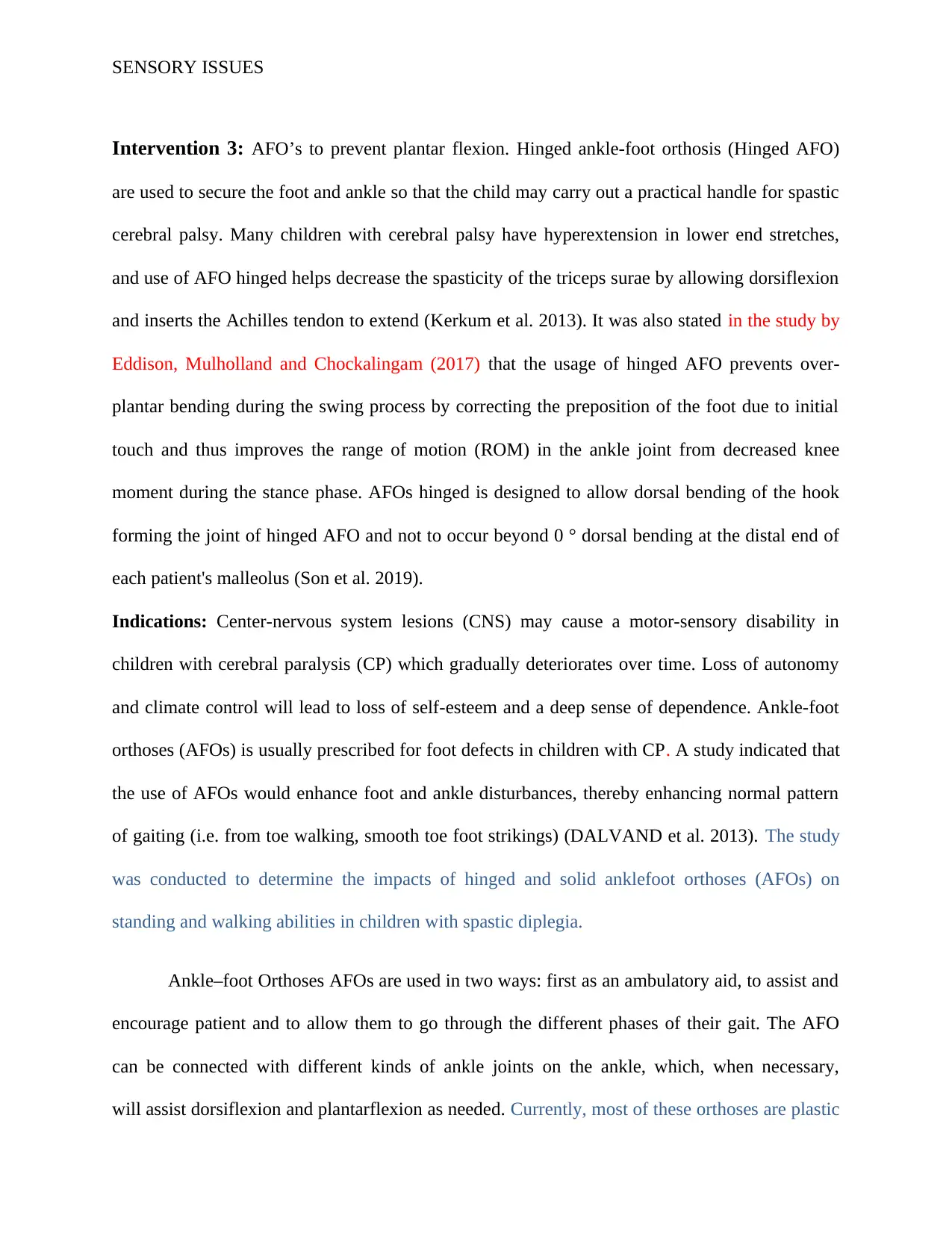
SENSORY ISSUES
Intervention 3: AFO’s to prevent plantar flexion. Hinged ankle-foot orthosis (Hinged AFO)
are used to secure the foot and ankle so that the child may carry out a practical handle for spastic
cerebral palsy. Many children with cerebral palsy have hyperextension in lower end stretches,
and use of AFO hinged helps decrease the spasticity of the triceps surae by allowing dorsiflexion
and inserts the Achilles tendon to extend (Kerkum et al. 2013). It was also stated in the study by
Eddison, Mulholland and Chockalingam (2017) that the usage of hinged AFO prevents over-
plantar bending during the swing process by correcting the preposition of the foot due to initial
touch and thus improves the range of motion (ROM) in the ankle joint from decreased knee
moment during the stance phase. AFOs hinged is designed to allow dorsal bending of the hook
forming the joint of hinged AFO and not to occur beyond 0 ° dorsal bending at the distal end of
each patient's malleolus (Son et al. 2019).
Indications: Center-nervous system lesions (CNS) may cause a motor-sensory disability in
children with cerebral paralysis (CP) which gradually deteriorates over time. Loss of autonomy
and climate control will lead to loss of self-esteem and a deep sense of dependence. Ankle-foot
orthoses (AFOs) is usually prescribed for foot defects in children with CP. A study indicated that
the use of AFOs would enhance foot and ankle disturbances, thereby enhancing normal pattern
of gaiting (i.e. from toe walking, smooth toe foot strikings) (DALVAND et al. 2013). The study
was conducted to determine the impacts of hinged and solid anklefoot orthoses (AFOs) on
standing and walking abilities in children with spastic diplegia.
Ankle–foot Orthoses AFOs are used in two ways: first as an ambulatory aid, to assist and
encourage patient and to allow them to go through the different phases of their gait. The AFO
can be connected with different kinds of ankle joints on the ankle, which, when necessary,
will assist dorsiflexion and plantarflexion as needed. Currently, most of these orthoses are plastic
Intervention 3: AFO’s to prevent plantar flexion. Hinged ankle-foot orthosis (Hinged AFO)
are used to secure the foot and ankle so that the child may carry out a practical handle for spastic
cerebral palsy. Many children with cerebral palsy have hyperextension in lower end stretches,
and use of AFO hinged helps decrease the spasticity of the triceps surae by allowing dorsiflexion
and inserts the Achilles tendon to extend (Kerkum et al. 2013). It was also stated in the study by
Eddison, Mulholland and Chockalingam (2017) that the usage of hinged AFO prevents over-
plantar bending during the swing process by correcting the preposition of the foot due to initial
touch and thus improves the range of motion (ROM) in the ankle joint from decreased knee
moment during the stance phase. AFOs hinged is designed to allow dorsal bending of the hook
forming the joint of hinged AFO and not to occur beyond 0 ° dorsal bending at the distal end of
each patient's malleolus (Son et al. 2019).
Indications: Center-nervous system lesions (CNS) may cause a motor-sensory disability in
children with cerebral paralysis (CP) which gradually deteriorates over time. Loss of autonomy
and climate control will lead to loss of self-esteem and a deep sense of dependence. Ankle-foot
orthoses (AFOs) is usually prescribed for foot defects in children with CP. A study indicated that
the use of AFOs would enhance foot and ankle disturbances, thereby enhancing normal pattern
of gaiting (i.e. from toe walking, smooth toe foot strikings) (DALVAND et al. 2013). The study
was conducted to determine the impacts of hinged and solid anklefoot orthoses (AFOs) on
standing and walking abilities in children with spastic diplegia.
Ankle–foot Orthoses AFOs are used in two ways: first as an ambulatory aid, to assist and
encourage patient and to allow them to go through the different phases of their gait. The AFO
can be connected with different kinds of ankle joints on the ankle, which, when necessary,
will assist dorsiflexion and plantarflexion as needed. Currently, most of these orthoses are plastic
Paraphrase This Document
Need a fresh take? Get an instant paraphrase of this document with our AI Paraphraser
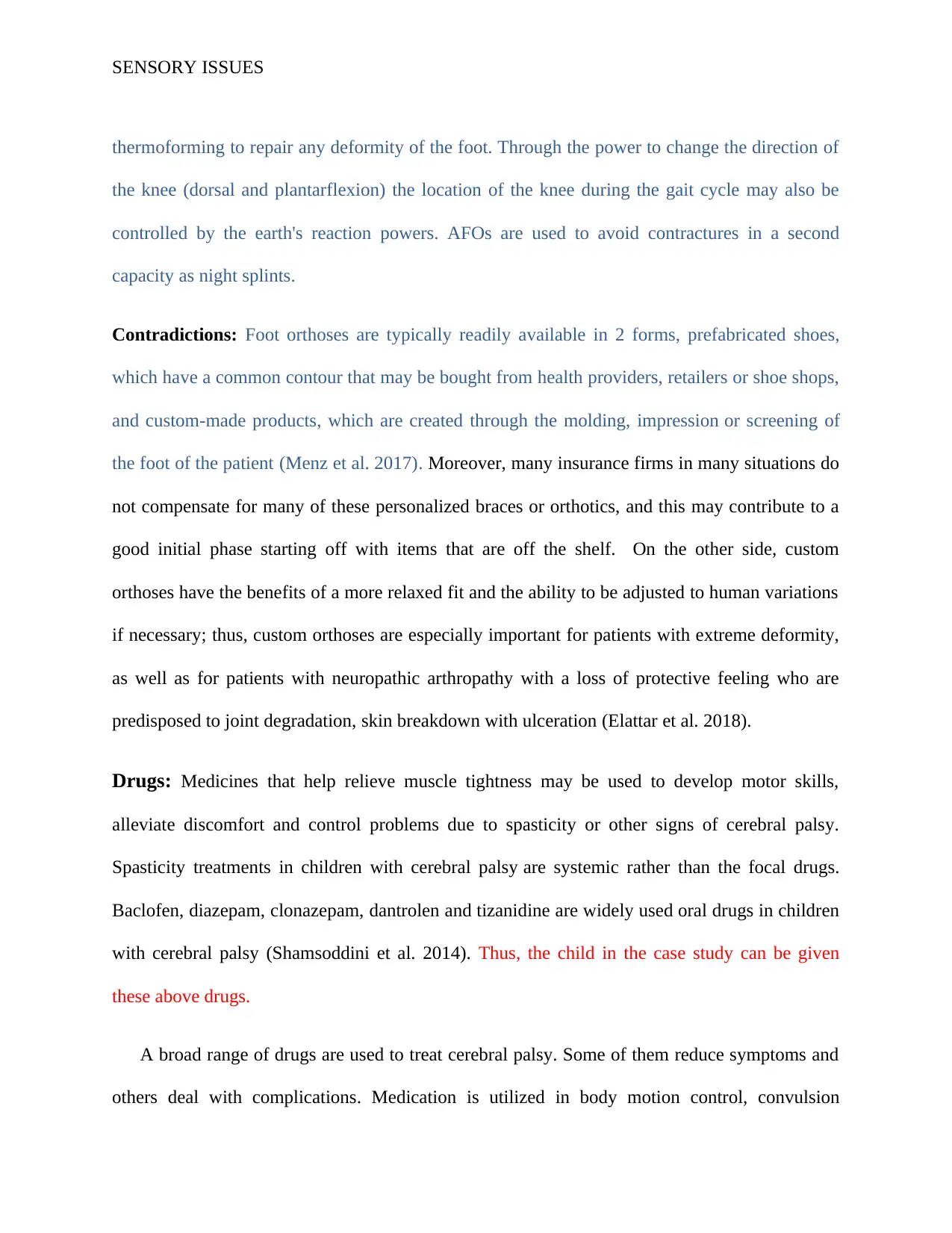
SENSORY ISSUES
thermoforming to repair any deformity of the foot. Through the power to change the direction of
the knee (dorsal and plantarflexion) the location of the knee during the gait cycle may also be
controlled by the earth's reaction powers. AFOs are used to avoid contractures in a second
capacity as night splints.
Contradictions: Foot orthoses are typically readily available in 2 forms, prefabricated shoes,
which have a common contour that may be bought from health providers, retailers or shoe shops,
and custom-made products, which are created through the molding, impression or screening of
the foot of the patient (Menz et al. 2017). Moreover, many insurance firms in many situations do
not compensate for many of these personalized braces or orthotics, and this may contribute to a
good initial phase starting off with items that are off the shelf. On the other side, custom
orthoses have the benefits of a more relaxed fit and the ability to be adjusted to human variations
if necessary; thus, custom orthoses are especially important for patients with extreme deformity,
as well as for patients with neuropathic arthropathy with a loss of protective feeling who are
predisposed to joint degradation, skin breakdown with ulceration (Elattar et al. 2018).
Drugs: Medicines that help relieve muscle tightness may be used to develop motor skills,
alleviate discomfort and control problems due to spasticity or other signs of cerebral palsy.
Spasticity treatments in children with cerebral palsy are systemic rather than the focal drugs.
Baclofen, diazepam, clonazepam, dantrolen and tizanidine are widely used oral drugs in children
with cerebral palsy (Shamsoddini et al. 2014). Thus, the child in the case study can be given
these above drugs.
A broad range of drugs are used to treat cerebral palsy. Some of them reduce symptoms and
others deal with complications. Medication is utilized in body motion control, convulsion
thermoforming to repair any deformity of the foot. Through the power to change the direction of
the knee (dorsal and plantarflexion) the location of the knee during the gait cycle may also be
controlled by the earth's reaction powers. AFOs are used to avoid contractures in a second
capacity as night splints.
Contradictions: Foot orthoses are typically readily available in 2 forms, prefabricated shoes,
which have a common contour that may be bought from health providers, retailers or shoe shops,
and custom-made products, which are created through the molding, impression or screening of
the foot of the patient (Menz et al. 2017). Moreover, many insurance firms in many situations do
not compensate for many of these personalized braces or orthotics, and this may contribute to a
good initial phase starting off with items that are off the shelf. On the other side, custom
orthoses have the benefits of a more relaxed fit and the ability to be adjusted to human variations
if necessary; thus, custom orthoses are especially important for patients with extreme deformity,
as well as for patients with neuropathic arthropathy with a loss of protective feeling who are
predisposed to joint degradation, skin breakdown with ulceration (Elattar et al. 2018).
Drugs: Medicines that help relieve muscle tightness may be used to develop motor skills,
alleviate discomfort and control problems due to spasticity or other signs of cerebral palsy.
Spasticity treatments in children with cerebral palsy are systemic rather than the focal drugs.
Baclofen, diazepam, clonazepam, dantrolen and tizanidine are widely used oral drugs in children
with cerebral palsy (Shamsoddini et al. 2014). Thus, the child in the case study can be given
these above drugs.
A broad range of drugs are used to treat cerebral palsy. Some of them reduce symptoms and
others deal with complications. Medication is utilized in body motion control, convulsion
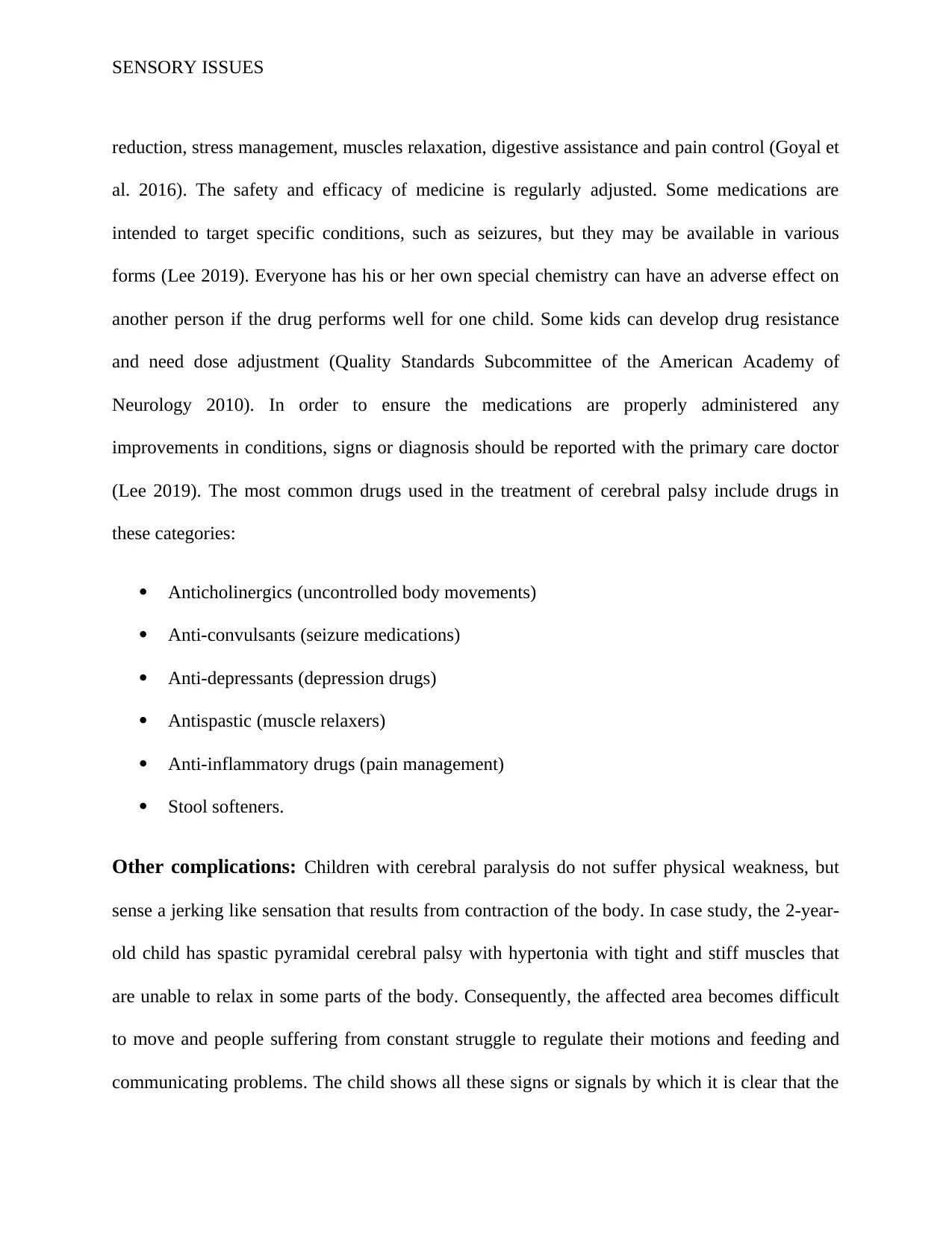
SENSORY ISSUES
reduction, stress management, muscles relaxation, digestive assistance and pain control (Goyal et
al. 2016). The safety and efficacy of medicine is regularly adjusted. Some medications are
intended to target specific conditions, such as seizures, but they may be available in various
forms (Lee 2019). Everyone has his or her own special chemistry can have an adverse effect on
another person if the drug performs well for one child. Some kids can develop drug resistance
and need dose adjustment (Quality Standards Subcommittee of the American Academy of
Neurology 2010). In order to ensure the medications are properly administered any
improvements in conditions, signs or diagnosis should be reported with the primary care doctor
(Lee 2019). The most common drugs used in the treatment of cerebral palsy include drugs in
these categories:
Anticholinergics (uncontrolled body movements)
Anti-convulsants (seizure medications)
Anti-depressants (depression drugs)
Antispastic (muscle relaxers)
Anti-inflammatory drugs (pain management)
Stool softeners.
Other complications: Children with cerebral paralysis do not suffer physical weakness, but
sense a jerking like sensation that results from contraction of the body. In case study, the 2-year-
old child has spastic pyramidal cerebral palsy with hypertonia with tight and stiff muscles that
are unable to relax in some parts of the body. Consequently, the affected area becomes difficult
to move and people suffering from constant struggle to regulate their motions and feeding and
communicating problems. The child shows all these signs or signals by which it is clear that the
reduction, stress management, muscles relaxation, digestive assistance and pain control (Goyal et
al. 2016). The safety and efficacy of medicine is regularly adjusted. Some medications are
intended to target specific conditions, such as seizures, but they may be available in various
forms (Lee 2019). Everyone has his or her own special chemistry can have an adverse effect on
another person if the drug performs well for one child. Some kids can develop drug resistance
and need dose adjustment (Quality Standards Subcommittee of the American Academy of
Neurology 2010). In order to ensure the medications are properly administered any
improvements in conditions, signs or diagnosis should be reported with the primary care doctor
(Lee 2019). The most common drugs used in the treatment of cerebral palsy include drugs in
these categories:
Anticholinergics (uncontrolled body movements)
Anti-convulsants (seizure medications)
Anti-depressants (depression drugs)
Antispastic (muscle relaxers)
Anti-inflammatory drugs (pain management)
Stool softeners.
Other complications: Children with cerebral paralysis do not suffer physical weakness, but
sense a jerking like sensation that results from contraction of the body. In case study, the 2-year-
old child has spastic pyramidal cerebral palsy with hypertonia with tight and stiff muscles that
are unable to relax in some parts of the body. Consequently, the affected area becomes difficult
to move and people suffering from constant struggle to regulate their motions and feeding and
communicating problems. The child shows all these signs or signals by which it is clear that the
⊘ This is a preview!⊘
Do you want full access?
Subscribe today to unlock all pages.

Trusted by 1+ million students worldwide
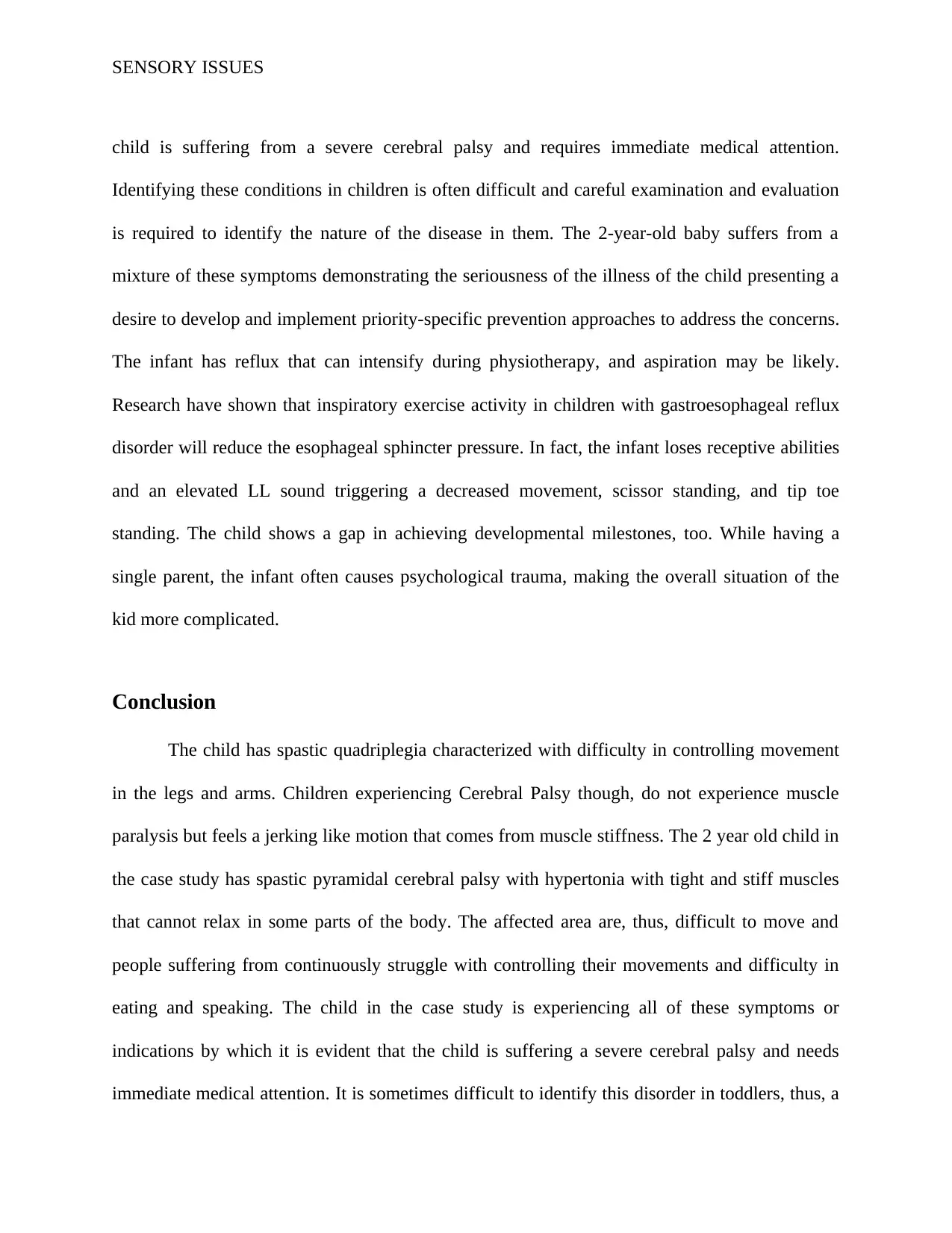
SENSORY ISSUES
child is suffering from a severe cerebral palsy and requires immediate medical attention.
Identifying these conditions in children is often difficult and careful examination and evaluation
is required to identify the nature of the disease in them. The 2-year-old baby suffers from a
mixture of these symptoms demonstrating the seriousness of the illness of the child presenting a
desire to develop and implement priority-specific prevention approaches to address the concerns.
The infant has reflux that can intensify during physiotherapy, and aspiration may be likely.
Research have shown that inspiratory exercise activity in children with gastroesophageal reflux
disorder will reduce the esophageal sphincter pressure. In fact, the infant loses receptive abilities
and an elevated LL sound triggering a decreased movement, scissor standing, and tip toe
standing. The child shows a gap in achieving developmental milestones, too. While having a
single parent, the infant often causes psychological trauma, making the overall situation of the
kid more complicated.
Conclusion
The child has spastic quadriplegia characterized with difficulty in controlling movement
in the legs and arms. Children experiencing Cerebral Palsy though, do not experience muscle
paralysis but feels a jerking like motion that comes from muscle stiffness. The 2 year old child in
the case study has spastic pyramidal cerebral palsy with hypertonia with tight and stiff muscles
that cannot relax in some parts of the body. The affected area are, thus, difficult to move and
people suffering from continuously struggle with controlling their movements and difficulty in
eating and speaking. The child in the case study is experiencing all of these symptoms or
indications by which it is evident that the child is suffering a severe cerebral palsy and needs
immediate medical attention. It is sometimes difficult to identify this disorder in toddlers, thus, a
child is suffering from a severe cerebral palsy and requires immediate medical attention.
Identifying these conditions in children is often difficult and careful examination and evaluation
is required to identify the nature of the disease in them. The 2-year-old baby suffers from a
mixture of these symptoms demonstrating the seriousness of the illness of the child presenting a
desire to develop and implement priority-specific prevention approaches to address the concerns.
The infant has reflux that can intensify during physiotherapy, and aspiration may be likely.
Research have shown that inspiratory exercise activity in children with gastroesophageal reflux
disorder will reduce the esophageal sphincter pressure. In fact, the infant loses receptive abilities
and an elevated LL sound triggering a decreased movement, scissor standing, and tip toe
standing. The child shows a gap in achieving developmental milestones, too. While having a
single parent, the infant often causes psychological trauma, making the overall situation of the
kid more complicated.
Conclusion
The child has spastic quadriplegia characterized with difficulty in controlling movement
in the legs and arms. Children experiencing Cerebral Palsy though, do not experience muscle
paralysis but feels a jerking like motion that comes from muscle stiffness. The 2 year old child in
the case study has spastic pyramidal cerebral palsy with hypertonia with tight and stiff muscles
that cannot relax in some parts of the body. The affected area are, thus, difficult to move and
people suffering from continuously struggle with controlling their movements and difficulty in
eating and speaking. The child in the case study is experiencing all of these symptoms or
indications by which it is evident that the child is suffering a severe cerebral palsy and needs
immediate medical attention. It is sometimes difficult to identify this disorder in toddlers, thus, a
Paraphrase This Document
Need a fresh take? Get an instant paraphrase of this document with our AI Paraphraser
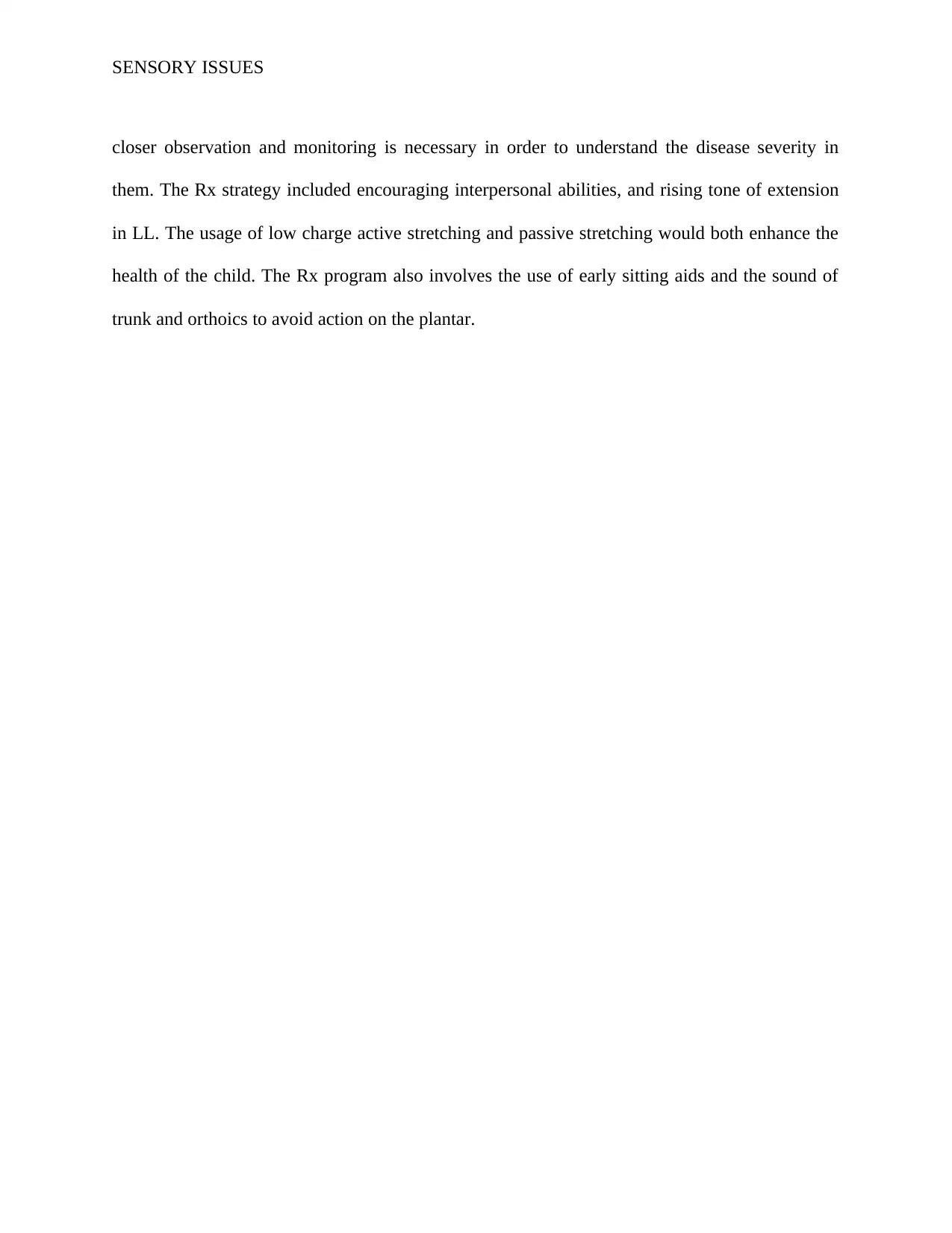
SENSORY ISSUES
closer observation and monitoring is necessary in order to understand the disease severity in
them. The Rx strategy included encouraging interpersonal abilities, and rising tone of extension
in LL. The usage of low charge active stretching and passive stretching would both enhance the
health of the child. The Rx program also involves the use of early sitting aids and the sound of
trunk and orthoics to avoid action on the plantar.
closer observation and monitoring is necessary in order to understand the disease severity in
them. The Rx strategy included encouraging interpersonal abilities, and rising tone of extension
in LL. The usage of low charge active stretching and passive stretching would both enhance the
health of the child. The Rx program also involves the use of early sitting aids and the sound of
trunk and orthoics to avoid action on the plantar.
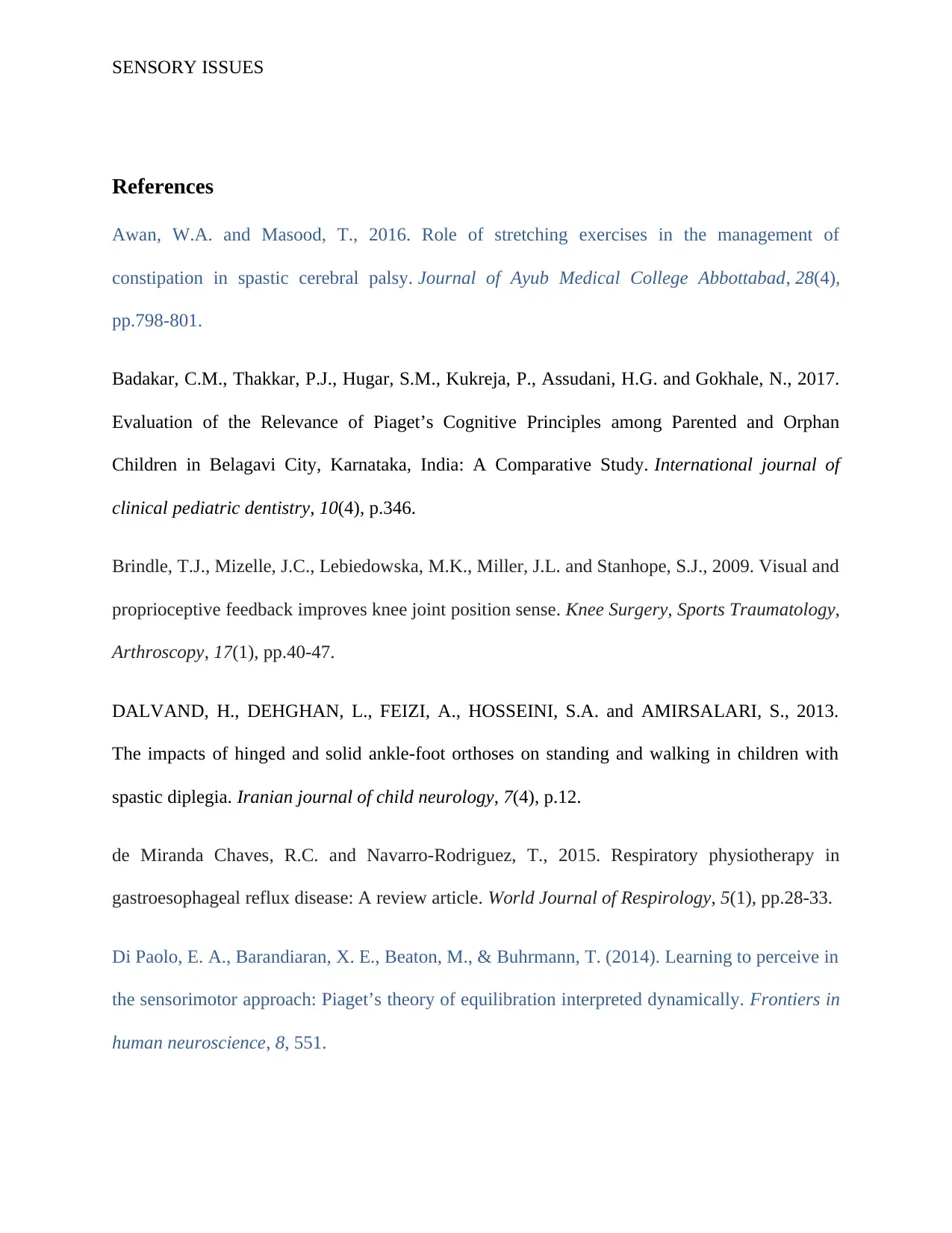
SENSORY ISSUES
References
Awan, W.A. and Masood, T., 2016. Role of stretching exercises in the management of
constipation in spastic cerebral palsy. Journal of Ayub Medical College Abbottabad, 28(4),
pp.798-801.
Badakar, C.M., Thakkar, P.J., Hugar, S.M., Kukreja, P., Assudani, H.G. and Gokhale, N., 2017.
Evaluation of the Relevance of Piaget’s Cognitive Principles among Parented and Orphan
Children in Belagavi City, Karnataka, India: A Comparative Study. International journal of
clinical pediatric dentistry, 10(4), p.346.
Brindle, T.J., Mizelle, J.C., Lebiedowska, M.K., Miller, J.L. and Stanhope, S.J., 2009. Visual and
proprioceptive feedback improves knee joint position sense. Knee Surgery, Sports Traumatology,
Arthroscopy, 17(1), pp.40-47.
DALVAND, H., DEHGHAN, L., FEIZI, A., HOSSEINI, S.A. and AMIRSALARI, S., 2013.
The impacts of hinged and solid ankle-foot orthoses on standing and walking in children with
spastic diplegia. Iranian journal of child neurology, 7(4), p.12.
de Miranda Chaves, R.C. and Navarro-Rodriguez, T., 2015. Respiratory physiotherapy in
gastroesophageal reflux disease: A review article. World Journal of Respirology, 5(1), pp.28-33.
Di Paolo, E. A., Barandiaran, X. E., Beaton, M., & Buhrmann, T. (2014). Learning to perceive in
the sensorimotor approach: Piaget’s theory of equilibration interpreted dynamically. Frontiers in
human neuroscience, 8, 551.
References
Awan, W.A. and Masood, T., 2016. Role of stretching exercises in the management of
constipation in spastic cerebral palsy. Journal of Ayub Medical College Abbottabad, 28(4),
pp.798-801.
Badakar, C.M., Thakkar, P.J., Hugar, S.M., Kukreja, P., Assudani, H.G. and Gokhale, N., 2017.
Evaluation of the Relevance of Piaget’s Cognitive Principles among Parented and Orphan
Children in Belagavi City, Karnataka, India: A Comparative Study. International journal of
clinical pediatric dentistry, 10(4), p.346.
Brindle, T.J., Mizelle, J.C., Lebiedowska, M.K., Miller, J.L. and Stanhope, S.J., 2009. Visual and
proprioceptive feedback improves knee joint position sense. Knee Surgery, Sports Traumatology,
Arthroscopy, 17(1), pp.40-47.
DALVAND, H., DEHGHAN, L., FEIZI, A., HOSSEINI, S.A. and AMIRSALARI, S., 2013.
The impacts of hinged and solid ankle-foot orthoses on standing and walking in children with
spastic diplegia. Iranian journal of child neurology, 7(4), p.12.
de Miranda Chaves, R.C. and Navarro-Rodriguez, T., 2015. Respiratory physiotherapy in
gastroesophageal reflux disease: A review article. World Journal of Respirology, 5(1), pp.28-33.
Di Paolo, E. A., Barandiaran, X. E., Beaton, M., & Buhrmann, T. (2014). Learning to perceive in
the sensorimotor approach: Piaget’s theory of equilibration interpreted dynamically. Frontiers in
human neuroscience, 8, 551.
⊘ This is a preview!⊘
Do you want full access?
Subscribe today to unlock all pages.

Trusted by 1+ million students worldwide
1 out of 15
Your All-in-One AI-Powered Toolkit for Academic Success.
+13062052269
info@desklib.com
Available 24*7 on WhatsApp / Email
![[object Object]](/_next/static/media/star-bottom.7253800d.svg)
Unlock your academic potential
Copyright © 2020–2025 A2Z Services. All Rights Reserved. Developed and managed by ZUCOL.